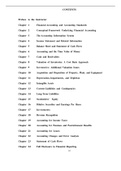Exam (elaborations)
Solutions Manual for Intermediate Accounting 12th Edition by Donald E. Kieso Jerry J. Weygandt Terry D. Warfield
- Course
- Institution
- Book
Solutions Manual for Intermediate Accounting 12th Edition by Donald E. Kieso Jerry J. Weygandt Terry D. Warfield (A Comprehensive Guide)
[Show more]



